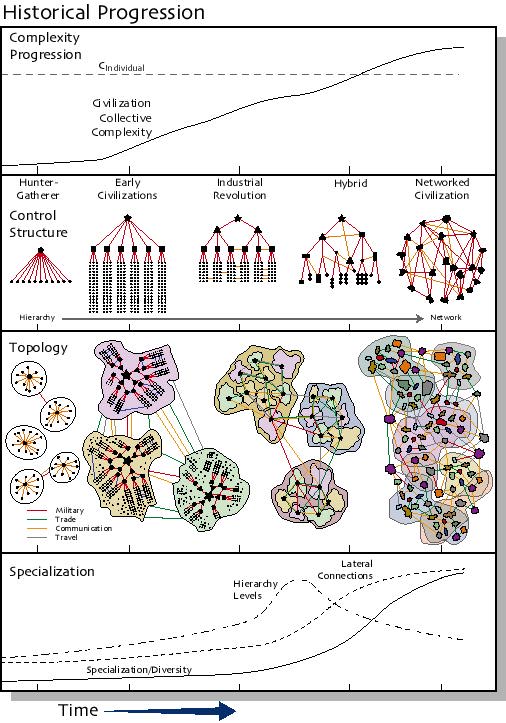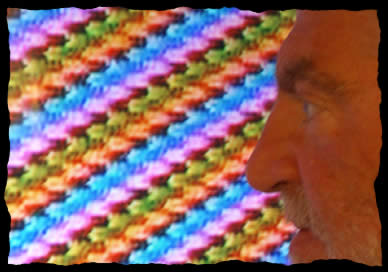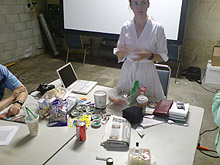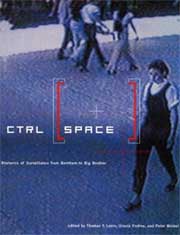
- Blogs (Apr 09, 2020)
- News (May 30, 2023)
- Organizations (Nov 04, 2023)
- People (Nov 03, 2023)
- Projects (Jun 24, 2019)
You can log-in or register for a user account here.


Narrator: Orson Wells | Parable: Warren H. Schmidt
Writer: Sam Weiss| Screenplay: Joseph Cavella
From Human Beings to Human Civilzation, a Complexity Profile

"A schematic history of human civilization reflects a growing complexity of the
collective behavior of human organizations. The internal structure of organizations
changed from the large branching ratio hierarchies of ancient civilizations,
through decreasing branching ratios of massive hierarchical bureaucracies,
to hybrid systems where lateral connections appear to be more important than the hierarchy.
As the importance of lateral interactions increases, the boundaries between subsystems become porous.
The increasing collective complexity also is manifest in the increaseing specialization and diversity of professions.
Among the possible future organizational structures are fully networked systems where hierarchical structures are unimportant."
- The New England Complex Systems Institute (NECSI) by Yaneer Bar-Yam
Re-Configure OSS, by Jason "JZ" Liszkiewicz, (cc) 1/18/06

CLICK IMAGE ABOVE TO WATCH HIS FLASH MOVIE AND/OR THIS ONE

What is Media Ecology?
Holographic Communication+Ambient & Mobile Intelligence

What is the Post-Digital ? ? ?
"ALIVE AND ANALOG"
From pre-digital to post-digital: 40 years of electronic art and music [3/01/06]
Art, Technology, and Culture Colloquium @ UC Berkeley's Center for New Media, by Steve Beck

"...tools for image making, sound, music, and communications are mature and ubiquitous.
How do we use these tools wisely, and what might be their implications and consequences?
What becomes of visual language, sensory and optimal perception?
Will diffusion of analog motifs result?
Creative necessity propels artistic realizations and explorations via hybrid electronic technologies. "
- - - - - > > > [podcast] < < < - - - - -
Food For Thought
ScienceAddiction, 95Theses, by Devanshu Mehta, 7/23/06
 | | |
| | |  | | |
| | | 
Wetware Hackers Day 2 | )( | Big tanks! | 0 | CTRL [SPACE] ???
We-Make-Money-Not-Art, 8/09/06
OR

OpenSourceEcology, Projects, 2007
OR . . .
| Animated Parable for the Busy and Preoccupied [#100] | Log-in or register a new user account | 0 Comments | |
|
| |
| Comments are statements made by the person that posted them. They do not necessarily represent the opinions of the site editor. |
- Apache HTTP Server
- Audacity [audio]
- Blender [3D suite]
- EMS Resources
- Firefox [browser]
- FreeCAD [modeler]
- GIMP.org [graphics]
- Inkscape [vector]
- LibreOffice
- Linux Kernel
- Mattermost [team]
- MediaWiki
- Moodle [LMS]
- Mozilla Hubs
- NetNewsWire
- Nightingale [music]
- OBS Studio
- QGIS [Geo-Info-Sys]
- Thunderbird [email]
- Thunderbird Lightning
- VLC [VideoLan]
- Wordpress [CMS]
- xiph Vorbis [ogg]
- XMPP [comm]
INTERNET ARCHIVE
WIKIMEDIA FOUNDATION
OPEN COURSEWARE
- Archive Educational
- Commons
- EdX
- Encyclopedia of Life
- HarvardX
- Harvard U
- CancerCommons
- Identity Mashup
- Merlot
- MIT OpenCourseware
- MITX
- Neuropathy Commons
- Northwestern U
- OpenCulture
- Open Edu Global
- Open Journal Systems
- OpenStax at Rice
- Open U OER
- Oregon State U
- SchoolForge
- Stanford U
- Tree of Life (glossary)
- U of Michigan
- U of Oxford
- Wikiversity
- Yale Open Courses
• Deep Learning
• Machine Learning
• Reinforcement Learning
• Artificial Intelligence
OPEN FORGES
OPEN METAVERSE
• Blender [3D Suite]
• Firestorm Viewer
• GitHub
• Libre3D
• Metaverse Project
• Mozilla Hubs
• NIH 3D Print Exchange
• OpenKinect
• OpenNI2
• OpenSim
• OpenSourceVR
• OpenWonderland
• PlayCanvas
• Sirikata
• Sketchfab
• Thingiverse
• 3D Warehouse
• Unity 3D
• WebGL (Moz)
• WebXR API (Moz)
• Yeggi
• YouMagine
- Arxiv at Cornell
- Arxiv Computer Research
- Arxiv Mathematics
- Arxiv NonLinear Sciences
- Arxiv Physics
- Arxiv Quantitative Biology
- Berkeley Electronic Press
- Free Legal Resources
- MediArXiv
- Public Library of Science (PLoS)
- PLoS ONE
- PLoS Biology
- PLoS Complex Systems
- PLoS CompBio
- PLoS Genetics
- PLoS Medicine
- Science Commons
- Smithsonian
- Alternative Freedom
- Brothers Chudnovsky
- Century of Self
- Conundrum
- Design-e2
- Digital Nation
- Einstein's Big Idea
- The Elegant Universe
- Evolution
- The Facebook Dilemma
- Fritjof Capra
- Generation Like
- The Grey Video
- Growing Up Online
- How Art Made the World
- In the Age of AI
- Last Child in the Woods?
- Life Incorporated
- Merchants of Cool
- Mirror Neurons
- OurMedia
- OS Media
- The Persuaders
- Plastic Wars
- Present Shock
- RecentChangesCamp06
- Revolution OS
- Who Owns Culture?
- Definition
- MP3 7.2MB
- More A/V
- Stanford Talk
Games- Agility
- Drawing
- OS Games
- Spelling
Media Ecology- Definition
- Tetrad of Effects
Optics- Dymaxion Map
- Hubble Telescope
- James Web Telescope
- Map - Territory
- Op Art
- Virtual Globe
- Visible Earth
Systems Science- 67th Proceedings
- 66th Proceedings
- 65th Proceedings
- 64th Proceedings
- 63rd Proceedings
- 62nd Proceedings
- 61st Proceedings
- 60th Proceedings
- 59th Proceedings
- 58th Proceedings
- 57th Proceedings
- 56th Proceedings
- 55th Proceedings
- 54th Proceedings
- 53rd Proceedings
- 52nd Proceedings
- 51st Proceedings
- 50th Proceedings
- Retrospective 12
- Retrospective 11
- Retrospective 10
- Retrospective 09
- Retrospective 08
- Retrospective 07
- Retrospective 06







